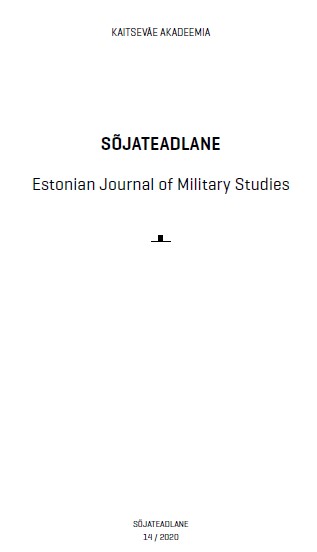„LAHINGUPIDAMISE TAKTIKA“ – TŠETŠEENI SÕDALASTELT TROFEENA SAADUD INSTRUKTSIOON
INSURGENT COMBAT TACTICS: A CHECHEN FIELD MANUAL
Author(s): Art Johanson, Üllar PetersonSubject(s): Military history, Political history, Security and defense, Military policy, Studies in violence and power, Transformation Period (1990 - 2010), Source Material, Peace and Conflict Studies
Published by: Kaitseväe Akadeemia (KVA)
Keywords: Insurgent combat tactics; Chechen Republic of Ichekeria; Chechnya’s independence; Chechen field manual of combat tactics:
Summary/Abstract: Following the 1991 August coup in Moscow, the Chechen Republic of Ichkeria was declared in the territory of the former Checheno-Ingush Autonomous Soviet Socialist Republic. However, the newly independent state was never recognized internationally, relegating it to the status of a politically secessionist area where the laws of the Russian Federation did not apply. The remaining Russian military units left the area in the summer of 1992, abandoning their armaments which were immediately seized by separatist Chechen forces. In 1994, Russia attacked the Chechen Republic of Ichkeria, launching the First Chechen War (1994–1996) where the Chechens managed to inflict heavy losses on the Russian forces. Due to the influx of money and volunteers from the Islamic world, the military operations of Shamil Basayev (1965–2006), and, most importantly, due to the dilapidated state of the Russian economy and army, the Chechens were able to regain their independence by the autumn of 1996. The subsequent period of Chechnya’s independence (1996–1999) demonstrated just how poorly prepared the Chechens were for independent statehood: the central government functioned only in the capital Grozny (renamed Dzhokhar-Ghala during this period), while elsewhere the territory was ruled by recalcitrant field commanders and local chieftans. Meanwhile, the Russian army, as well as the Russian public at large, were much better prepared for the Second Chechen War which began in October 1999. By March 2000 most of Chechnya was conquered and the pro-independence forces had retreated to the mountains. By 2002 armed resistance had subsided into guerrilla warfare. By 2004 the pro-independence forces had about a thousand men whose leadership sought to maintain the vision of the Chechen Republic of Ichkeria. At the same time, the Kadyrov dynasty came to power in Chechnya, supported by the Russians. Surprisingly for a war-torn nation, the new leadership managed to secure popular support. Today, substantive resistance in Chechnya has come to an end. However, there are some moderate Chechen nationalists keeping alive the image of the independent Chechnya in the West, but nothing has been heard of them lately. The Chechen field manual of combat tactics, a short booklet of a mere dozen pages, seized by the Russians as a war trophy, has hereby been translated into Estonian. The document indicates that its original publisher is the National Defence Committee – an advisory body to the government of the Chechen Republic of Ichkeria that was formed by the secessionist leadership in 2002 and headed by Shamil Basayev, one of the most experienced field commanders of the Chechen independence movement.
Journal: Sõjateadlane
- Issue Year: 2020
- Issue No: 14
- Page Range: 117-134
- Page Count: 18
- Language: Estonian

